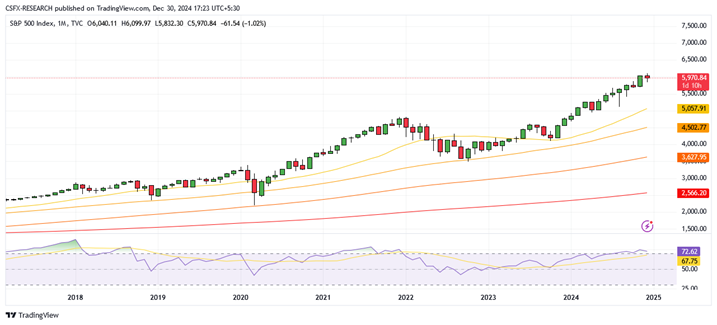US Stock Market 2025 Forecast: Could Earnings Growth Propel the S&P 500 to 6,800 by Year-End?
- The S&P 500 is projected to climb 7-14% in 2025, potentially reaching 6,800, fueled by robust corporate earnings and the continued expansion of AI-driven technologies.
- While AI leaders such as Nvidia and Microsoft spearheaded market gains in 2024, sectors like healthcare and energy are anticipated to take the lead in 2025. Tech sector earnings are expected to grow by 20%, surpassing the broader market’s estimated 12% growth.
- The U.S. economy is forecast to grow by 2.5% in 2025, with inflation stabilizing at 2.4%, slightly above the Federal Reserve’s target. Although potential Fed rate cuts could bolster market performance, a “higher for longer” monetary policy approach may temper growth in high-valuation sectors.
2024 U.S. Stock Market Review and 2025 Outlook: Will the Rally Sustain?
As 2024 comes to an end, Wall Street looks back on yet another year of remarkable gains. The S&P 500 has climbed roughly 25%, and the Nasdaq Composite has soared by about 31%, echoing the robust performance seen in 2023. Investors with well-diversified portfolios have enjoyed significant returns, as major indices reached record highs. However, after two years of outstanding growth, many are now pondering whether the bullish momentum can persist in 2025 or if a potential slowdown is on the horizon.
2024 in Review: Sustaining the Momentum of Economic Growth
Despite challenges from inflation and rising interest rates, the U.S. economy showcased impressive resilience in 2024. GDP is projected to finish the year at 2.8%, fueled by consistent consumer spending and solid job growth. The unemployment rate has remained steady at 4.2%, while inflation has declined significantly from its 2022 peak of over 9%, settling at 2.7%. Retail activity, travel, and dining maintained robust momentum throughout the year, further supporting economic growth.
A standout theme of 2024 was the explosive growth in artificial intelligence (AI) investments. Companies invested billions in AI infrastructure, semiconductor advancements, and data centers. Nvidia (NVDA) emerged as a trailblazer in this transformation, spearheading the market rally and symbolizing Wall Street’s enthusiasm for AI. Microsoft (MSFT) and Alphabet (GOOGL) also made significant strides, harnessing AI to enhance their cloud computing and enterprise solutions. However, as the year unfolded, tech valuations began to exhibit signs of overheating, with several leading stocks retreating from their November peaks.
2025 Economic Forecast: Gradual Yet Stable Growth
Economists predict that the U.S. economy will sustain its momentum into 2025, albeit at a slower pace. GDP growth is forecasted at 2.5%, indicating steady but tempered expansion. Inflation is expected to stabilize at 2.4%, marginally exceeding the Federal Reserve’s 2% target yet remaining manageable within the broader economic landscape.
Monetary policy from the Federal Reserve will play a critical role in influencing market trends. While markets are pricing in two 25-basis-point rate cuts in 2025, Fed officials have adopted a more cautious tone, emphasizing the risk of reaccelerating inflation. This “higher for longer” approach could constrain gains for high-valuation equities, particularly in sectors sensitive to interest rates.
Financial giants like JPMorgan Chase (JPM) and Goldman Sachs (GS) are well-positioned to thrive in this environment. Elevated interest rates tend to enhance bank profitability through improved net interest margins, while sustained economic growth is likely to support loan demand and investment banking activity.
2025 Market Forecast: S&P 500 Projections

The outlook for the S&P 500 in 2025 is cautiously optimistic, with analysts predicting the index could rise to between 6,400 and 6,800, which would imply potential gains of 7% to 14% from current levels. However, some strategists caution that after two consecutive years of 20%+ returns, the chances of achieving similar results in 2025 are lower. Historically, when the S&P 500 experiences back-to-back 20% gains, the following year tends to see an average return of 7%, with a 67% probability of positive performance.
A key factor driving the continued growth of the S&P 500 will be corporate earnings, which are expected to increase by 15% in 2025, up from an estimated 9.5% growth in 2024. Notably, earnings in the tech sector are forecast to grow at a faster rate of approximately 20%, underscoring the sector’s dominant role in overall market expansion.
Key Sectors to Monitor: Potential Opportunities and Risks
Technology will remain a dominant force in 2025, with further growth expected in AI-related investments. While Nvidia continues to be a strong contender, investors may exercise caution due to the sector’s elevated valuations. Analysts predict tech sector earnings to grow by 20%, surpassing the broader market’s anticipated 12% growth.
Healthcare is poised for a potential recovery. The sector lagged in 2024, posting only a 3% gain. However, historical trends show that biotech stocks often outperform the broader market after the first rate cut in a Federal Reserve easing cycle. Eli Lilly (LLY) and Amgen (AMGN) are seen as key growth candidates, with Eli Lilly benefiting from its blockbuster weight-loss drugs and Amgen offering defensive stability.
Industrials and energy sectors are also expected to benefit from ongoing infrastructure investments and reshoring initiatives. General Electric (GE) is capitalizing on the rising demand in aviation and renewable energy, while ExxonMobil (XOM) and NextEra Energy (NEE) remain strong energy options. Exxon’s reliable dividend payouts and NextEra’s leadership in renewables offer investors a mix of stability and growth potential.
Political and Fiscal Policy: The Effects of Trump’s Policies
President Trump’s potential return to the White House presents both opportunities and uncertainties for markets. His pro-business policies, such as tax cuts and deregulation, are anticipated to stimulate further capital investment, benefiting sectors like financials, energy, and industrials. However, Trump’s proposal of 25% tariffs on Canadian and Mexican goods and a 10% tax on Chinese imports raises concerns about potential risks, which could slow growth and negatively impact multinational corporations.
Analysts are divided on the significance of these policies. While some view the tariffs as a negotiation strategy, others caution about possible disruptions to global supply chains. Nevertheless, there is widespread agreement that fiscal stimulus and infrastructure spending may offset these risks and continue to drive expansion.
Conclusion; A Balanced Approach for 2025
As investors approach 2025, focusing on diversification and effective risk management will be crucial. Although the economic outlook remains positive, market valuations are high, and potential challenges should not be overlooked. The S&P 500, expected to rise to between 6,400 and 6,800, suggests cautious optimism but highlights the importance of a well-rounded portfolio. Allocating to defensive sectors like healthcare, maintaining exposure to AI and leading technology stocks, and balancing equity positions with bonds can help build resilience as the market faces slower growth and potential volatility.
In the end, while the rally may persist, 2025 is expected to bring heightened volatility and a more discerning market, making careful asset allocation key to securing sustained returns in both the S&P 500 and the broader market.

